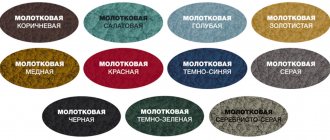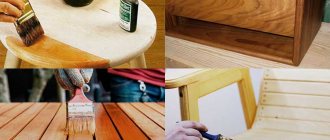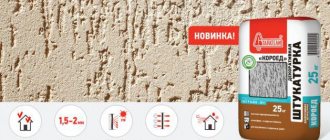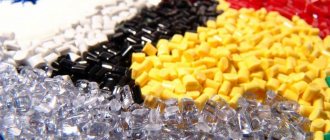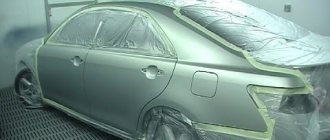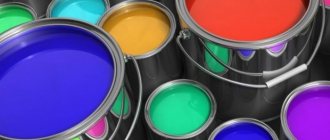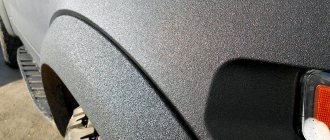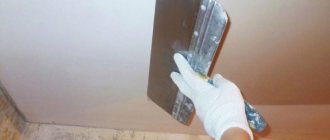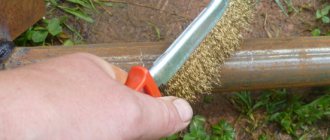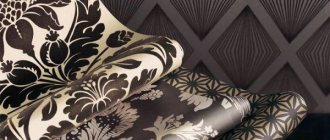Glass wallpaper is a modern, high-strength finishing material that will decorate any apartment. They can withstand scratches from animals, strollers, bicycles, etc.
This is an environmentally friendly material, so you can safely glue them in the children's room.
In addition, with their help it is easy to change the color simply by repainting them, rather than re-pasting the wallpaper completely.
From the article you will learn how to paint glass wallpaper with your own hands and what paint to choose.
Preparatory work
Before painting glass wallpaper for painting, it is necessary to perform simple preparatory work, then the work will be simple and even inexperienced craftsmen can do it.
After gluing and complete drying of the glass wallpaper, use a roller to cover the entire surface with a primer.
It significantly improves adhesion and the final result of painting, giving textured glass wallpaper brightness and good quality.
As a primer, you can use glue diluted with water or an ordinary wall primer.
Painting methods
Painting embossed wallpaper is usually done using a spray gun or a regular roller with long pile, and a narrow brush will help to paint the corners.
These tools will ensure even application of the paint composition to the canvas.
It is better to start painting glass wallpaper with a narrow brush from the upper and lower areas, as well as corners, after which you can use a roller.
If the walls and ceiling are covered with glass wallpaper, then you should always start from the ceiling.
You need to paint the entire surface of the wall at once, without allowing individual areas to dry, otherwise the transition boundaries will be noticeable in these places.
Painting is done in two layers, allowing the first to dry for about 12 hours.
To make the final result more decorative, glass wallpaper can be painted using various techniques:
- using borders;
- using stencils;
- squeegee staining;
- painting with azure.
Use of borders
Using borders you can very easily improve the interior of any room. This is one of the most commonly used methods of painting fiberglass wallpaper.
With this method, two options are possible:
- choose fiberglass wallpaper with a pattern of the same texture at the top and bottom of the border;
- choose a pattern of canvas of different textures in relation to the border.
Markings are first applied to the wall, the upper and lower parts are painted in two layers with an interval of 12 hours, and after 10 hours of drying, a border suitable for the relief is glued.
Screen painting
Using stencils, a geometric composition, ornament, and pattern are created on glass wallpaper. It is necessary that the selected pattern matches the texture of the glass wallpaper.
After painting and drying the canvases, using masking tape, the desired pattern is applied to the surface.
The application of patterns must be done slowly and carefully; a piece of foam rubber or sponge will do.
Be careful not to get paint under the masking tape. After a day, carefully remove it.
Squeegee staining
Squeegee staining impresses with its simplicity and efficiency. With this method, the first layer of paint should be deep and intense.
After drying, apply a water-based varnish or a composition with a metallic tint.
After 20 - 25 minutes, the applied last layer is carefully spread with a rubber spatula over the surface of the glass wallpaper.
The top layer and excess are cleaned off with a dampened sponge; the paint remains only in the relief recesses of the wallpaper.
Azure
Using azure you can achieve all sorts of color schemes. First, a layer of paint is applied using a roller or spray gun.
After the canvases have dried, the glaze is applied with a flat brush, transverse, small strokes. After 15 - 20 minutes, use a rubber spatula to spread the glaze evenly over the surface.
To achieve a more intense color scheme, you need to cover the wallpaper with glaze 2 times.
If you plan to repaint glass wallpaper several times, then choose them with a deeper relief pattern, then it will not become clogged with paint longer.
Painting and gluing glass wallpaper
Basic information
Fiberglass wallpaper is one of the most practical finishing materials for both industrial and residential premises. A huge variety of textures and woven patterns offered by manufacturers, as well as modern technology and excellent technical characteristics of the material, provide great opportunities for both interior design in traditional, classic styles, and for bold design experiments.
Photo: if everything is done correctly, the result will please you
No less, or even more important, than texture is color. It is he who sets the tone for the interior. Let's recall the basic principles of how to choose colors:
- Light colors visually enlarge the room, while dark colors make it smaller.
- Pleasant natural shades calm and help you relax, bright and sharp shades excite.
- It is good to decorate different functional areas in the room with different colors, while observing a certain unified principle for the entire interior.
How best to glue
Before gluing glass wallpaper for painting, it is necessary to take into account some features.
- Be careful and make sure where the front and back sides are before you start gluing. The fact is that, despite the fact that at first glance they are similar, in fact they are different. As a rule, the manufacturer marks both sides, or at least one of them.
- As for the choice of glue, it is necessary to use a special glue designed for gluing heavy types of wallpaper.
- Be sure to wear gloves before cutting as contact with the material may cause irritation to unprotected skin.
- They must be glued end-to-end, and the working surface must first be primed.
Glass wallpaper must be glued end-to-end
Attention! Before painting fiberglass wallpaper, it is also recommended to prime it! The primer is made using the same adhesive solution, only diluted with water. It is necessary to reduce paint consumption, since untreated surfaces have an increased ability to absorb.
After you have completed all of the above steps, you can proceed to the process of painting the wallpaper.
Painting rules
When purchasing, you have different options. You can immediately choose glass wallpaper for painting in a suitable color, or you can buy colorless ones and paint them in the desired color. However, even if you bought colored ones, after a while you will probably want changes in the interior - and then nothing will stop you from painting them in any other color, because glass wallpaper can be repainted repeatedly - the greater the depth of the texture, the more layers of paint can be applied before than it will finally smooth out.
Please note that it is advisable to pre-treat the surfaces with a primer.
To make your walls delight you with their beautiful appearance, you should follow a few simple rules:
- Before gluing, it is better to make sure that the wall (and in some cases, the ceiling) on which you are gluing the wallpaper should be level. Before priming the surface, it is necessary to prepare it perfectly. The fact is that glass wallpaper will perfectly mask minor wall defects - small cracks, roughness, etc., but there should not be large cracks or unevenness. Perhaps, after wallpapering, they will not immediately make themselves felt, but after painting, the “bubbles” will certainly become noticeable.
- Allow the wallpaper to dry completely before painting. At the same time, just as when gluing ordinary wallpaper, drafts should not be allowed into the room. Drying time is from twelve hours to a day. It is usually indicated on the glue package. Then you can safely paint.
- Very often, when applying the first layer, the paint consumption turns out to be more than indicated on the container. To save paint, first prime the wallpaper with wallpaper glue diluted according to the instructions on the container and let it dry. During subsequent painting, the paint consumption will not be more than usual.
- As when painting any porous surfaces, in their reviews and recommendations, experts recommend applying the paint as follows: the first layer is applied with vertical strokes, the second with horizontal strokes, or vice versa. You can also apply paint using a sprayer.
- Before applying the second coat, you should wait until the paint is completely dry, which requires at least 12 hours.
- Try to apply paint only in the required quantities. An excessively thick layer of paint helps smooth out the texture more quickly.
If you have the tools and basic skills, it’s quite possible to do all the work yourself
Like other wall coverings, glass wallpaper makes it possible to use combinations of two or more colors in the interior, and here the border of two colors does not necessarily have to be a straight line.
If this does not contradict the concept suggested by the texture, you can paint drawings - bright, or, conversely, in soft pastel colors, depending on your tastes and the purpose of the room. This is a job that requires great precision and care. It is better to apply the paint using a stencil, or entrust it to a specialist.
What quality paint should I choose for fiberglass wallpaper?
This depends on both the design goals and the purpose of the room. For design purposes, you can choose matte or glossy paint. The matte surface looks softer and more voluminous. Glass wallpaper coated with matte paint can be indistinguishable in appearance from ordinary fabrics. Glossy paint will emphasize the relief, the surface will seem harder, more “technical”.
Photo: a textured surface like matting or cobwebs looks especially attractive
As for the types of patterns on the surface, the most common are the following patterns:
What to paint with?
Depending on the purpose of the room, we choose less or more durable paint. Which ones are better? For a bathroom where there is high humidity, for a kitchen or hallway where there is a risk of staining the wall, you should choose paints that are most resistant to abrasion.
Pay attention to the product characteristics indicated on the packaging. The painting of glass wallpaper itself can be carried out using stencil or squeegee technology.
To paint wallpaper, different types of paint are used - acrylic, polyurethane, latex, water-emulsion and water-dispersion. The main thing is to make sure when purchasing that this paint is suitable for fiberglass wallpaper.
How to paint fiberglass wallpaper, video instructions:
How to paint glass wallpaper, choice of paint
The main requirement when choosing paints and varnishes for wallpaper for painting is that they must be diluted only with water (water-dispersed compositions).
Water-dispersed paints are non-toxic, penetrate well into the wallpaper material and dry quickly.
Types of water-dispersion paints
- Butadione styrene paint. It is quite moisture resistant, which makes it possible to use it as the main material for painting glass wallpaper. But it should be taken into account that under the influence of sunlight it can fade very quickly.
- Latex based paint. An excellent option for painting wallpaper with a deep textured structure.
- Acrylic paints. The most popular choice. A wide range of colors, high UV resistance, ease of use and the possibility of wet cleaning.
When purchasing paint, remember that glass wallpaper can only be painted with good quality materials.
In cheap materials, chalk is often used as a filler; it will clog up the entire relief of the canvas.
To paint fiberglass wallpaper or not: pros and cons
Fabric-based fiberglass wallpaper has undeniable advantages:
- the fabric is resistant to tears, scratches and abrasion;
- the material is environmentally friendly;
- the material has increased antistatic properties;
- after gluing to the wall, the risk of developing mold and mildew is reduced;
- There is an additional possibility of repainting.
On the building materials market, you can choose a suitable shade of fabric base that fits well into the interior design. Fiberglass wallpaper is produced taking into account the needs of modern customers. They are characterized as an environmentally friendly and antistatic material with high aesthetic characteristics.
In this case, there is the possibility of additional painting of the surface after glass wallpaper is glued to the wall. Coloring is carried out for several reasons:
- to change the color of the walls (if the wrong shade was chosen);
- to update the interior;
- to hide possible defects.
Owners often practice purchasing white or gray glass wallpaper and then painting it. According to technologists, high-quality material can withstand 20 to 30 repaints. The service life of the fabric base on fiberglass is 30 years.
The surface painting option has its pros and cons.
Advantages and disadvantages
Change of interior
Choice of any color
Ease of use
There is no need to replace the material with new one
Large amounts of paint will be required due to the porosity of the material
With each coloring, the material’s ability to transmit steam decreases.
Popular paint manufacturers
Below are the most popular paints for glass wallpaper according to consumer reviews.
Tikkurila Harmony
High quality paint with no odor, low consumption and fast drying. Suitable for children's and bedrooms.
Tikkurila Harmony paint is available on the construction market in a wide variety of matte colors.
Thanks to the quality, appearance and price, Tikkurila Harmony buyers leave only positive reviews about it.
Tikkurila Euro 2
This is a matte paint with latex added. Suitable for dry rooms.
Mattlatex Dufa
This is latex paint, highly durable, matte colors, economical when painting.
Adhesive compositions for fiberglass
Before studying the topic of how to glue fiberglass, it is better to get acquainted with the features of adhesive mixtures for it.
Types of adhesive composition
Building materials stores sell 2 types of such compositions: ready-made, packaged in plastic buckets, and dry powders in paper bags.
- Ready-made glue (5, 10 liters or larger volume). When purchasing it, you need to check the manufacturing date on the container. Otherwise, you can purchase expired goods, and the result of the work will be the appearance of bubbles. Another potential problem is peeling of the canvas due to poor adhesion. It is recommended to use open containers in the near future, since there is no guarantee that the composition will not lose its characteristics.
- Dry powder. This is a more practical option, since this type of glue costs less, but allows dosed use - only in the required volume. Prepare glue in strict accordance with the instructions on the package. If there are no other instructions, then pour the powder into warm water, stirring constantly. The prepared composition is kept for about 10-15 minutes, because it must swell. Then the glue is stirred again.
The third possible option is PVA, but with only one condition. Fiberglass has a fairly low density, so the glue will soon turn yellow in the light. This color change will definitely affect the light coating. If the choice fell on PVA, it is better to choose dark colors. However, special mixtures are better: they contain additional additives that give the material maximum strength.
Glass fiber adhesive brands
Since fiberglass can be glued using the same compounds as glass wallpaper, the range to choose from is quite wide. The most popular brands include mixtures of several manufacturing companies.
- Quelyd is a French brand. Under it, a large number of different adhesives for wallpaper, wallpaper removers, sealants and mastics are produced. The most popular product for glass wallpaper is Optima.
- Oscar is a Swedish brand, the compositions are produced in Russia. The glue, ready-made or dry, is characterized by minimal consumption and high strength. Additionally contains fungicides that prevent the formation of mold.
- Kleo is another “French”. This company specializes in the production of dry adhesives for glass wallpaper and fiberglass. The products are distinguished by high quality, but affordable price, quick preparation of the mixture, and the same drying time.
- Pufas is a German candidate for surface repair. The manufacturer produces paint and varnish coatings, adhesives, and primer mixtures. Glass wallpaper products are famous for their excellent adhesive properties.
- Bostik is another brand from France. The company produces various adhesive compositions, but the most famous is the parquet mixture. Despite the low price, adhesive mixtures for canvas guarantee reliable coating and easy joining of canvases.
Other worthy contenders include products from Spektrum (Sweden), Nortex, Wellton, Bolars (Russia).
Folk alternative
There is a recipe that allows you to make a decent adhesive composition with your own hands. To do this, mix:
- 1 pack of regular (cheap) dry wallpaper glue;
- 1 kg PVA;
- 5 liters of warm water.
First, dry glue is mixed with water to obtain a homogeneous composition without lumps. After this, PVA is poured in. This sequence allows you to avoid clots consisting of PVA and dry undiluted powder.
Is it necessary to paint glass wallpaper?
Typically fiberglass wallpaper is white and is usually painted.
You don’t have to paint it if you are happy with their appearance and they fit your interior in this form, but white wallpaper that needs to be painted may look unpresentable.
You should not paint glass wallpaper in bright colors, as this color will quickly get boring and you will have to repaint it.
They also produce colored glass wallpaper - they can also be painted, but this is not necessary.
Choosing a color
Color selection
Once it has been decided which paint to use, the correct shade should be selected. In most cases, the decisive factor will be the own opinion and taste preferences of the residents of the house. But it is still recommended to adhere to general recommendations:
- It is better not to choose bright and catchy shades, as in the near future the color will become boring and irritating.
- To create bright accents, it is better to make various colored inserts that will look advantageous against a background of pastel shades.
- The color of the walls should be combined and harmonize with the furniture and decorative elements.
- When using stencils, pay attention to the small pattern, which will also visually change the geometry of the room, and large elements will find a place on the walls in spacious rooms.
Using several colors in the interior of a room will visually expand the space. This is true for small rooms.

